Table of Contents
CHAPTER 8
VITAL VILLAGES, THRIVING TOWNS
Prabhakar at the blacksmith’s shop
Prabhakar sat watching the smiths at the local shop. There was a small bench on which iron tools like axes and sickles were laid out, ready for sale. A bright fire was burning, and two men were heating and beating metal rods into shape. It was very hot and noisy, and yet it was fascinating to watch what was happening.
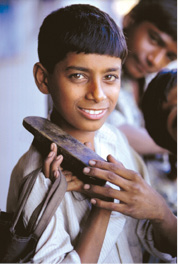
Iron tools and agriculture
We often take the use of iron for granted today. Things made of iron (and steel) are a part of our daily lives. The use of iron began in the subcontinent around 3000 years ago. Some of the largest collections of iron tools and weapons were found in the megalithic burials, about which you read in Chapter 4.
Around 2500 years ago, there is evidence for the growing use of iron tools. These included axes for clearing forests, and the iron ploughshare. As we had seen (Chapter 5) the ploughshare was useful for increasing agricultural production.
Other steps to increase production: irrigation
The kings and kingdoms you have been reading about could not have existed without the support of flourishing villages. While new tools and the system of transplantation (Chapter 5) increased production, irrigation was also used. Irrigation works that were built during this time included canals, wells, tanks, and artificial lakes.

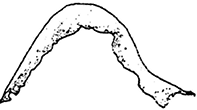

Iron tools.
Here is a set of captions.Choose the right one for each of the pictures.
Sickle, tongs, axe.
Prepare a list of at least five objects made of iron or steel that you use almost everyday.
If you look at the chart, you will find that some of the stages in the construction of irrigation works are mentioned.
Fill in the rest by using the following phrases:
• Labour is provided by the people.
• Farmers also benefit because crop production is more certain.
• Farmers have to increase production to pay taxes.
• Kings provide money and plan irrigation works.
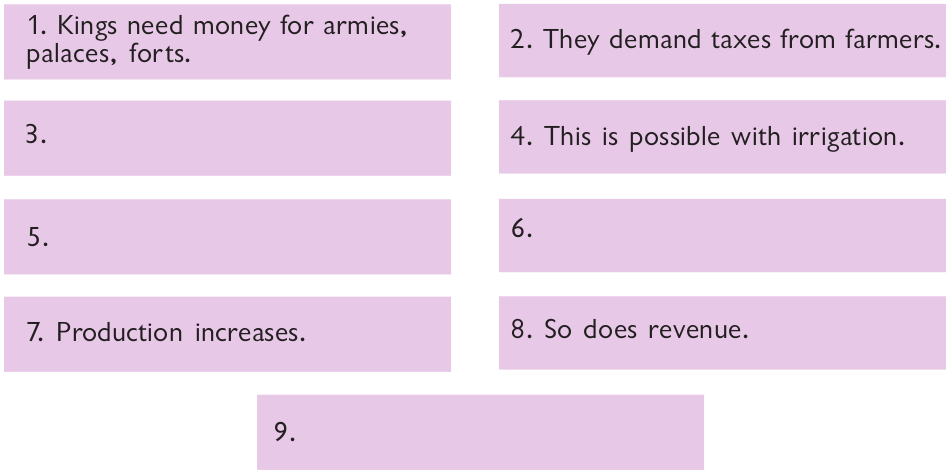
Who lived in the villages?
There were at least three different kinds of people living in most villages in the southern and northern parts of the subcontinent. In the Tamil region, large landowners were known asvellalar, ordinary ploughmen were known asuzhavar, and landless labourers, including slaves, were known askadaisiyarandadimai.
In the northern part of the country, the village headman was known as thegramabhojaka. Usually, men from the same family held the position for generations. In other words, the post was hereditary. Thegramabhojakawas often the largest landowner. Generally, he had slaves and hired workers to cultivate the land. Besides, as he was powerful, the king often used him to collect taxes from the village. He also functioned as a judge, and sometimes as a policeman.
Apart from thegramabhojaka,there were other independent farmers, known asgrihapatis, most of whom were smaller landowners. And then there were men and women such as thedasakarmakara,who did not own land, and had to earn a living working on the fields owned by others.
In most villages there were also some crafts persons such as the blacksmith, potter, carpenter and weaver.
The earliest Tamil compositions
Some of the earliest works in Tamil, known asSangamliterature, were composed around 2300 years ago. These texts were calledSangambecause they were supposed to have been composed and compiled in assemblies (known assangams) of poets that were held in the city of Madurai (see Map 7, page 105). The Tamil terms mentioned above are found in Sangam literature.
Finding out about cities: stories, travellers, sculpture and archaeology
You may have heard of the Jatakas. These were stories that were probably composed by ordinary people, and then written down and preserved by Buddhist monks. Here is part of a Jataka story, which tells us how a poor man gradually became rich.
The clever poor man
Once upon a time, there was a clever poor young man who lived in a city. His only resource was a dead rat. He started off by selling it for a coin to a hotel, for their cat.
Then one day, there was a storm. The king’s garden was littered with branches and leaves, and the gardener was at a loss as to how to clear the mess. The young man offered to clean the garden if he could keep the wood and leaves. The gardener agreed at once.
The young man rounded up all the children who were playing, with an offer of sweets for every stick and leaf that they could collect. In no time, every scrap had been neatly piled near the entrance. Just then, the king’s potter was on the look out for fuel with which to bake his pots. So he took the whole lot and paid the young man for it.
Our young man now thought of another plan. He carried a jar full of water to the city gate, and offered water to 500 grass cutters. They were pleased and said: “You have done us a good turn. Tell us, what can we do for you?”
He replied, “I’ll let you know when I need your help.”
He then made friends with a trader. One day, the trader told him: “Tomorrow, a horse dealer is coming to town with 500 horses.” Hearing this, our young man went back to the grass cutters. He said: “Please give me a bundle of grass each, and don’t sell your grass till mine is sold.” They agreed, and gave him 500 bundles of grass.
When the horse dealer could not buy grass anywhere else, he purchased the young man’s grass for a thousand coins. …
List the occupations of the persons mentioned in the story.
For each one, try and decide whether they would have lived (a) only in the city (b) only in villages (c) in both cities and villages.
Why do you think the horse dealer was coming to the city?
Do you think women could have taken up the occupations mentioned in the story? Give reasons for your answer.
We can use other kinds of evidence to find out about life in some of these early cities. Sculptors carved scenes depicting peoples’ lives in towns and villages, as well as in the forest. Many of these sculptures were used to decorate railings, pillars and gateways of buildings that were visited by people.

Below : A sculpture from Sanchi.
This is a sculpture from Sanchi, a site withstupas, in Madhya Pradesh, showing the scene in a city. You will learn more about Sanchi in Chapter 11.Notice the way walls are shown. Are they made of brick, wood or stone? Now look at the railings. Are they made of wood? Describe the roofs of the buildings.
Many of the cities that developed from about 2500 years ago were capitals of the mahajanapadas that you learnt about in Chapter 5. As we had seen, some of these cities were surrounded by massive fortification walls.
In many cities, archaeologists have found rows of pots, or ceramic rings arranged one on top of the other. These are known as ring wells. These seem to have been used as toilets in some cases, and as drains and garbage dumps. These ring wells are usually found in individual houses.
We have hardly any remains of palaces, markets, or of homes of ordinary people. Perhaps some are yet to be discovered by archaeologists. Others, made of wood, mud brick and thatch, may not have survived.

Another way of finding out about early cities is from the accounts of sailors and travellers who visited them. One of the most detailed accounts that has been found was by an unknown Greek sailor. He described all the ports he visited. Find Bharuch on Map 7 (page 105) and then read his description of the city.
The Story of Barygaza (the Greek name for Bharuch)
The gulf is very narrow at Barygaza, and very hard to navigate for those coming from the sea.
Ships had to be steered in by skilful and experienced local fishermen who were employed by the king.
The imports into Barygaza were wine, copper, tin, lead, coral, topaz, cloth, gold and silver coins.
Exports from the town included plants from the Himalayas, ivory, agate, carnelian, cotton, silk and perfumes.
Special gifts were brought by merchants for the king. These included vessels of silver, singing boys, beautiful women, fine wines and fine cloth.
Make a list of all the things imported and exported from Barygaza. Underline at least two things that were not in use during Harappan times.
Why do you think merchants brought gifts for the king?
Punch-marked Coins
Punch-marked coins were generally rectangular or sometimes square or round in shape, either cut out of metal sheets or made out of flattened metal globules (a small spherical body). The coins were not inscribed, but were stamped with symbols using dies or punches. Hence, they are called
punch-marked coins. These coins are found over most parts of the subcontinent and remained in circulation till the early centuries CE.
Coins
You may have noticed how wealth is measured in terms of coins in the story on page 82. Archaeologists have found several thousands of coins belonging to this period. The earliest coins which were in use for about 500 years were punch marked coins, such as the one shown below.
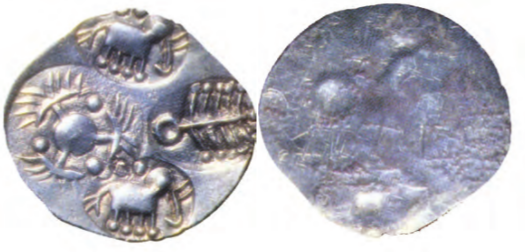
Other means of exchange
Read this short poem from the Sangam collection:
As they carry the white paddy of their land
To exchange it for the salt of another,
Crossing the long roads in carts,
Through sands white as moonlight,
Taking whole families,
Who hate to be left behind,
The departure of the salt merchants
Leaves the city empty.
Salt was produced plentifully along the sea coast.
What are the merchants planning to exchange it with?
How are they travelling?
Cities with many functions
Very often, a single town was important for a variety of reasons. Let us look at the example of Mathura (Map 7, page 105).
Mathura has been an important settlement for more than 2500 years. It was important because it was located at the cross roads of two major routes of travel and trade — from the northwest to the east and from north to south. There were fortifications around the city, and several shrines. Farmers and herders from adjoining areas provided food for people in the city. Mathura was also a centre where some extremely fine sculpture was produced.
Around 2000 years ago Mathura became the second capital of the Kushanas, about whom you will be reading in Chapter 9. Mathura was also a religious centre — there were Buddhist monasteries, Jaina shrines, and it was an important centre for the worship of Krishna.
Several inscriptions on surfaces such as stone slabs and statues have been found in Mathura. Generally, these are short inscriptions, recording gifts made by men (and sometimes women) to monasteries and shrines. These were made by kings and queens, officers, merchants, and crafts persons who lived in the city. For instance, inscriptions from Mathura mention goldsmiths, blacksmiths, weavers, basket makers, garland makers, perfumers.
Make a list of the occupations of people who lived in Mathura. List one occupation that was not practised in Harappan cities.
Crafts and crafts persons
We also have archaeological evidence for crafts. These include extremely fine pottery, known as the Northern Black Polished Ware (NBPW). It gets its name from the fact that it is generally found in the northern part of the subcontinent.
Northern BlackPolished Ware (NBPW)
NBPW is a hard, wheel made, metallic looking ware with a shiny black surface. The potter used to expose the earthenware to very high temperature in his kiln which resulted in the blackening of its outer surface. A fine black slip was also applied on this, which gave the pottery a mirror-like shine.
Remember that the archaeological evidence for many crafts may not have survived. We know from texts that the manufacture of cloth was important. There were famous centres such as Varanasi in the north, and Madurai in the south. Both men and women worked in these centres.
Many crafts persons and merchants now formed associations known as shrenis. These shrenis of crafts persons provided training, procured raw material, and distributed the finished product. Then shrenis of merchants organised the trade. Shrenis also served as banks, where rich men and women deposited money. This was invested, and part of the interest was returnedor used to support religious institutions suchas monasteries.
Rules for spinning and weaving
These rules are from the Arthashastra, mentioned in Chapter 7. They describe how spinning and weaving could be done in workshops under the supervision of a special official.
“Widows, young women who are differently abled, nuns, mothers of courtesans, retired women servants of the king, women who have retired from service in temples, may be used for processing wool, bark, cotton, hemp and flax.
They should be paid according to the quality and quantity of work.
Women who are not permitted to leave their homes can send maid-servants to bring the raw material from the superintendent, and take the finished work back to him.
Women who can visit the workshop should go at dawn to give their work and receive their wages. There should be enough light to examine the work. In case the superintendent looks at the woman or talks about anything other than the work, he should be punished.
If a woman does not complete her work, she will have to pay a fine, and her thumbs can be cut off.”
Make a list of all the women who could be employed by the superintendent.
Do you think women would have faced any problems while working?
A closer look — Arikamedu
Find Arikamedu (in Puducherry) on Map 7 (page 105), and read the box on Rome on
page 88. Between 2200 and 1900 years ago, Arikamedu was a coastal settlement where ships unloaded goods from distant lands. A massive brick structure, which may have been a warehouse, was found at the site. Other finds include pottery from the Mediterranean region, such as amphorae (tall double-handled jars that contained liquids such as wine or oil) and stamped red-glazed pottery, known as Arretine Ware, which was named after a city in Italy. This was made by pressing wet clay into a stamped mould. There was yet another kind of pottery which was made locally, though Roman designs were used. Roman lamps, glassware and gems have also been found at the site.
page 88. Between 2200 and 1900 years ago, Arikamedu was a coastal settlement where ships unloaded goods from distant lands. A massive brick structure, which may have been a warehouse, was found at the site. Other finds include pottery from the Mediterranean region, such as amphorae (tall double-handled jars that contained liquids such as wine or oil) and stamped red-glazed pottery, known as Arretine Ware, which was named after a city in Italy. This was made by pressing wet clay into a stamped mould. There was yet another kind of pottery which was made locally, though Roman designs were used. Roman lamps, glassware and gems have also been found at the site.
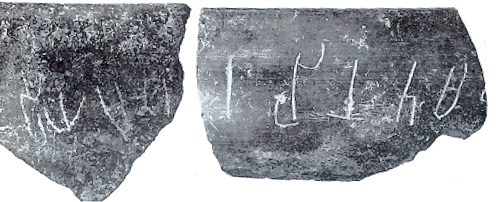
Tamil-Brahmi inscriptions.
Several pieces of pottery have inscriptions in Brahmi, which was used to write Tamil.
Small tanks have been found that were probably dyeing vats, used to dye cloth. There is plenty of evidence for the making of beads from semi-precious stones and glass.
List the evidence that indicates that there was contact with Rome.
Elsewhere
Find Rome on Map 6 (page 76). This is one of the oldest cities in Europe, and developed around the same time as the cities in the Ganga valley. Rome was the capital of one of the largest empires — one that spread across Europe, North Africa, and West Asia. Augustus, one of the most important emperors, who ruled about 2000 years ago, said that he found Rome a city of brick, and made it into a city of marble. He, and later rulers, built temples and palaces.
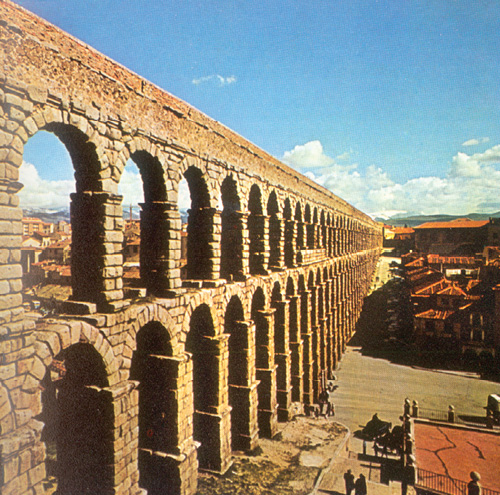
They also built huge amphitheatres — open arenas surrounded by tiers of seats — where citizens could watch all kinds of shows, and public baths (with separate timings for men and women), where people met and relaxed. Huge aqueducts — channels to supply water — were built to bring water to the city — for the baths, fountains and toilets.
Why do you think the amphitheatres and aqueducts have survived?
Imagine
You live in Barygaza and are visiting the port. Describe what you would see there.
Keywords
iron
irrigation
village
port
ring well
city
shreni
Sangam
Some Important Dates
- Beginning of the use of iron in the subcontinent (about 3000 years ago)
- Increase in the use of iron, cities, punch marked coins (about 2500 years ago)
- Beginning of the composition of Sangam literature (about 2300 years ago)
- Settlement in Arikamedu (between 2200 and 1900 years ago)
Let’s recall
1. Fill in the blanks:
(a) ———————— was a word used for large landowners in Tamil.
(b) The gramabhojaka often got his land cultivated by the ————————
(c) Ploughmen were known as ———————— in Tamil.
(d) Most grihapatis were ———————— landowners.
2. Describe the functions of the gramabhojaka. Why do you think he was powerful?
3. List the crafts persons who would have been present in both villages and cities.
4. Choose the correct answer:
(a) Ring wells were used for:
1. bathing
2. washing clothes
3. irrigation
4. drainage
(b) Punch marked coins were made of:
1. silver
2. gold
3. tin
4. ivory
(c) Mathura was an important:
1. village
2. port
3. religious centre
4. forested area
(d) Shrenis were associations of:
1. rulers
2. crafts persons
3. farmers
4. herders
Let’s discuss
5. Which of the iron tools shown on page 79 would have been important for agriculture? What would the other tools have been used for?
6. Compare the drainage system in your locality with that of the cities mentioned in the lesson. What similarities and differences do you notice?
Let’s do
7. If you have seen crafts persons at work, describe in a short paragraph what they do. (Hint: how do they get the raw materials, what kind of equipment do they use, how do they work, what happens to the finished product).
8. List the functions performed by men and women who live in your city or village. In what ways are these similar to those performed by people who lived in Mathura? In what ways are they different?
